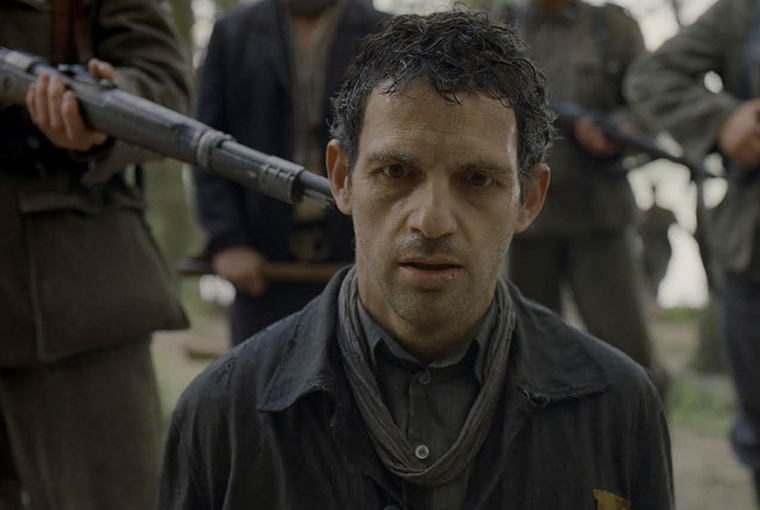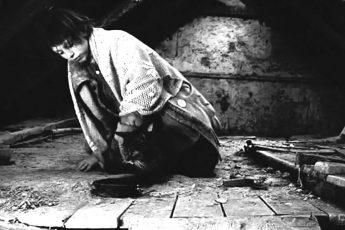“You failed the living for the dead.”
László Nemes’ Son of Saul (Saul fia, 2015)
Vol. 66 (Summer 2016) by Jack Page
Nemes’ Son of Saul is an unflinching and sobering portrayal of one man’s final search for atonement in the living nightmare of World War II. Set within the confines of the Auschwitz concentration camp in 1944, Jewish prisoner Saul is a Hungarian member of the Sonderkommando who is required to assist in the maintenance of the gas chambers. He scrubs the blood from the floors, dumps the corpses and reclaims any potential valuables from the victims’ clothing that they leave behind. Upon seeing a young boy among the murdered masses he alleges is his own son, Saul preoccupies himself with finding a Rabbi to allow the dead a proper Jewish burial as the other inmates of the camp organize an imminent uprising.
Son of Saul’s unusual formatting of the frame and its unique use of cinematography immediately construct a claustrophobic aesthetic style. With the additional use of natural lighting, there is a constant madness omnipresent in the small, negative spaces surrounding Saul, a flurry of blurred movement that is unrelenting to a suffocating extent. Shot entirely with a 40mm lens and in Academy aspect ratio, the image it produces has a very shallow depth of field and a narrow field of vision. This aesthetic visualizes Saul’s lack of freedom, holding Saul like a prisoner inside the frame, chained to its every movement. In addition to this sense of immobility, Saul’s body language and gestures are also restricted to the confines of the shot, so much so, that the audience is expected to rely on the consistent emotive close-ups of Saul instead. These disembodied portraits of Saul contain some the film’s most powerful imagery. With very little dialog (there were few German/ Hungarian translators at Auschwitz), the viewer is left to communicate with Saul’s morbid gaze. The lifelessness behind his eyes and the dark, heavy bags beneath them resemble a spectral stare. Torment and sadness are etched into the dirty wrinkles and grooves of his face. The ashes of the dead settle and collect on his eyebrows and hair. But Saul’s appearance is unremarkable in comparison to the other prisoners and he remains anonymous, navigating his way through the labyrinthine camp seemingly undetected. Saul symbolizes the everyman, a survivor on borrowed time and a shadow of the person he once was.
The portrayal of Saul’s condition is not a damning one. He is merely a byproduct of the concentration camp, a forced participant who is active in his duties inasmuch as he is ordered to. Yet Saul’s quest to bury his son and his unclear religious motivation for it raises questions of moral culpability. Why does a Jewish prisoner of war embark on a journey of salvation? What does Saul need to be redeemed for? Is he plagued by a moral cowardice to refuse to revolt in the face of certain death? Nemes has no expectation of holding Saul accountable for events he did not even begin to set in motion, let alone support their rationale. Saul’s knowingly last act on Earth seems to be driven partly out of absolution, but mainly out of madness.
As a result of the film’s aesthetic being purposefully restrictive in its representation of life in the camp, diegetic sound plays an integral role in recreating the illusion of realism that is imagined by the viewer. Although the lens often obstructs the amount of information on-screen (lack of background setting detail, blurred mise-en-scène, faceless supporting characters), the visceral visuals that we lose in the shot are compensated for by a dynamic use of surround sound design and sound stage effects. Distinct conversations can be heard simultaneously emanating from both sides of off-screen space, every scream, wretch, high-pitched cry and violent altercation can be heard with an unbearable sharpness. Adopting Saul’s olfactory senses of sight and sound, the audience bears witness to the camp. However, the numbness with which Saul carries out his orders and the other nihilistic members of the Sonderkommando ensure that this alignment is as dispassionate as possible. The complete absence of a soundtrack not only intensifies the already heightened sense of realism, but it serves to act as a prevention for any kind of escapism for the viewer. That is to say, paradoxically, Nemes refuses to remind the spectator that Son of Saul is just a film. Instead, the only relief from the harrowing aural tension is the short breaks of silence that follow the executions.
Inexorably, as with any fictional recreation of disastrous real-life events, issues of ethics, fidelity and tastefulness are likely to skew the way in which an audience watches a film. Nemes removes himself from any manipulative conventions of Hollywood cinema in his representation of the Holocaust. There are no grandiose moments of salvation, no sweeping, dramatic gestures of performance. Yet the filmmaker has crystallized the very essence of the horrors of war in a most challenging and purified way. The result is a far more affecting narrative than traditional depictions of Holocaust cinema. In this respect, Son of Saul does offer an unprecedented cinematic experience. But what do we have left to learn from another Holocaust film? Is it a cruel reminder? Is it entertainment or art? When does the story of the persecution of the Jews become exploitative? What do filmmakers and audiences alike have to gain from it? In exploring the theme of war and in particular this case of genocide, it is impossible not to find some kind of tragic spectacle.
The spectacle may be that of the degree of reality depicted (its level of historical accuracy) or the spectacle of evil (violence and gore). Even these two strands are inseparable in and of themselves when it comes to war and its onscreen manifestations. In the present cultural climate of undesirable remakes, reboots, spin-offs and sequels, it is strange to see another Holocaust film – however much critically acclaimed – avoid criticism for its rehashing of the past. There is no shortage of preexisting Holocaust films and the genre seems to struggle to find new material and treatment. So what really justifies the existence of Son of Saul? Is it to debunk the mythologized naivety of Hollywood’s version of the Holocaust? If so, then I would urge anyone to first look at more definitive case studies such as Claude Lanzmann’s ten hour epic Shoah (1985) or Alain Resnais groundbreaking documentary Night and Fog (1955). These exposés are arguably key foundations in the canon of Holocaust cinema and the collective memory in which contemporary cinema has us perceive and discuss it.




Leave a Comment